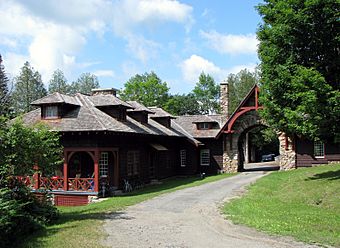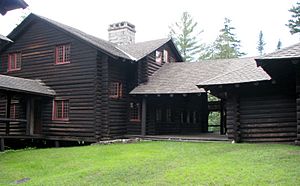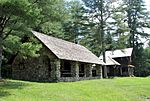Santanoni Preserve facts for kids
|
Camp Santanoni
|
|
 |
|
| Location | Newcomb Lake |
|---|---|
| Nearest city | Newcomb, New York |
| Area | 12,990 acres (52.6 km2) |
| Architect | Robertson, Robert H.; Delano & Aldrich |
| MPS | Great Camps of the Adirondacks TR |
| NRHP reference No. | 86002955 |
Quick facts for kids Significant dates |
|
| Added to NRHP | April 03, 1987 |
| Designated NHL | May 16, 2000 |
The Santanoni Preserve was once a huge private estate covering about 13,000 acres (53 km2). It is located in the beautiful Adirondack Mountains in Newcomb, New York. Today, this amazing place belongs to the State of New York and is open for everyone to enjoy.
Contents
Discovering Santanoni's Past: A Journey Through Time
How Camp Santanoni Began: A Rich History
The Santanoni Preserve was created by Robert C. Pruyn (1847–1934). He was a very important banker and businessman from Albany. Pruyn bought about 12,900 acres (52.2 km2) of land in Newcomb, near the Adirondack High Peaks. He hired a famous architect, Robert H. Robertson, to design a special summer home complex. This was in the late 1800s.
New Owners and a Sad Event: The Melvin Family Era
In 1953, Pruyn's family sold the Santanoni Preserve to the Melvin family. The Melvins were also important business people from Syracuse, New York. They enjoyed the camp for nearly 20 years. However, in 1971, a sad event happened. One of their young grandchildren went missing in the forest and was never found. Because of this tragedy, the family decided not to return to the camp.
Becoming a State Preserve: A New Chapter for Santanoni
Soon after the sad event, the Melvin family sold the entire Santanoni Preserve. They sold it to the Adirondack Conservancy Committee, which is part of The Nature Conservancy. The Conservancy then sold the property to the State of New York. This made Santanoni part of the State Forest Preserve.
For about 20 years, the state did not take good care of the buildings at Camp Santanoni. This was because of a rule in the New York State Constitution. This rule said that wilderness areas should be kept "forever wild." This meant that buildings were supposed to be removed. However, this idea later changed, and the buildings were saved.
Exploring Camp Santanoni: A National Treasure
What Makes Camp Santanoni Special: A Great Adirondack Camp
Camp Santanoni is a group of about 45 buildings within the larger Santanoni Preserve. It was one of the very first "Great Camps of the Adirondacks." These camps were large, fancy summer homes built by wealthy families. Today, Camp Santanoni is known as the Camp Santanoni Historic Area. It is also a National Historic Landmark, which means it's a very important historical site. When it was finished, many people thought Camp Santanoni was the grandest of all the Adirondack camps.
The Three Main Areas: Gate Lodge, Farm, and Main Camp
Camp Santanoni has three main groups of buildings. These are the Gate Lodge complex, the farm complex, and the Main Camp. The buildings for the Main Camp were built in 1892–93 by Robert H. Robertson. The farm buildings were designed around 1902 by Edward Burnett, a top farm designer. The Gate Lodge was designed in 1905 by William Adams Delano. He was from the famous New York City architectural firm of Delano and Aldrich.
The Gate Lodge Complex: A Grand Welcome
The Gate Lodge complex is located at the edge of the town of Newcomb. It features an impressive Gate Lodge with a huge stone archway. This complex also included six bedrooms for staff, a home for the caretaker, and various barns and sheds.
The Farm Complex: Supplying the Camp
About a mile further into the estate was the farm complex. It had large barns, three farmhouses, and cottages for workers. There was also a stone creamery, a workshop, a chicken house, kennels, and other service buildings. Santanoni had one of the biggest farm operations ever seen on a family estate in the Adirondacks. It raised many types of animals, including cattle, sheep, goats, pigs, and chickens. The farm provided all the meat and produce for the camp. Extra dairy products were sold in Newcomb and sent to Albany for the Pruyn family and their friends. Many people in Newcomb still have old milk bottles with "Santanoni" written on them!
The Main Camp: Lakeside Living
The Main Camp is about 4.7 miles (7.6 km) from the Gate Lodge complex. It sits on the shore of Newcomb Lake, offering amazing views of the Adirondack High Peaks. The central lodge was actually six separate buildings connected by one large roof and porch system. It included a main living and dining lodge with two bedrooms. There were also four sleeping cabins with seven more bedrooms. A kitchen and service building had seven staff bedrooms.
About 1500 spruce trees were used to build this log structure. The camp shows off amazing rustic Adirondack Architecture. It has log grill work on the eaves, birch-bark on the walls, and hand-carved beams. The main living area has a two-story high ceiling and impressive stone fireplaces. These features make Santanoni a fantastic example of log construction and rustic design.
Next to the central lodge, along the lake, were a boathouse and an artist's studio. This studio was built for Pruyn's son, Edward Lansing Pruyn, who was an artist. Hidden in the woods behind the main lodge were another caretaker's home, a workshop, an ice house, and other service buildings. A bit further away, on the road from the farm, were two more staff homes and another horse and carriage barn.
Architectural Influences: A Touch of Japan
The design of Camp Santanoni shows influences from Japanese architecture. This is especially clear in the single roof and continuous porch that connects five of the six main buildings. The roof has steps, like Japanese roofs, and looks like a bird in flight when seen from above. This bird is like the symbolic phoenix.
This Japanese influence makes sense because owner Robert C. Pruyn had a special connection to Japan. His father, Robert H. Pruyn, was appointed by President Abraham Lincoln in 1861 to be a minister (like an ambassador) to Japan. He was only the second such ambassador after Commodore Perry opened trade with Japan. The Pruyn family was very well-known in New York's business, political, and social circles. Robert C. Pruyn was also an aide to Governor Dix and president of a major bank. Famous visitors like Theodore Roosevelt and James Fenimore Cooper, Jr. often visited the Pruyns at their Adirondack camp.
Saving Santanoni: A Story of Preservation
After many years, a group called Adirondack Architectural Heritage worked hard to save the historic buildings. In 1993, the state agreed to keep most of them. Since then, the New York State Department of Environmental Conservation, Adirondack Architectural Heritage, and the Town of Newcomb have been restoring the structures. They have received grants from programs like the federal Save America's Treasures and the New York State Environmental Protection Fund. Funds from the Getty Foundation also helped create a plan to guide all the restoration work.
Santanoni Preserve was recognized for its historical importance in 1986. It was added to the National Register of Historic Places in 1987. In 2000, it was declared a National Historic Landmark.
Visiting Santanoni: What to Expect
Santanoni Preserve is open all year round. In the summer, you can walk, bike, or even ride a horse-drawn wagon down the historic road. In winter, you can go cross-country skiing or snowshoeing. Many of the building interiors, especially at the main camp, are open during certain seasons. From July 4th through Labor Day, friendly staff offer free tours at the camp. These tours happen daily at 11 am, 1 pm, and 3 pm.
The Santanoni Preserve is located on Newcomb Lake, just north of the small town of Newcomb.
Gallery









